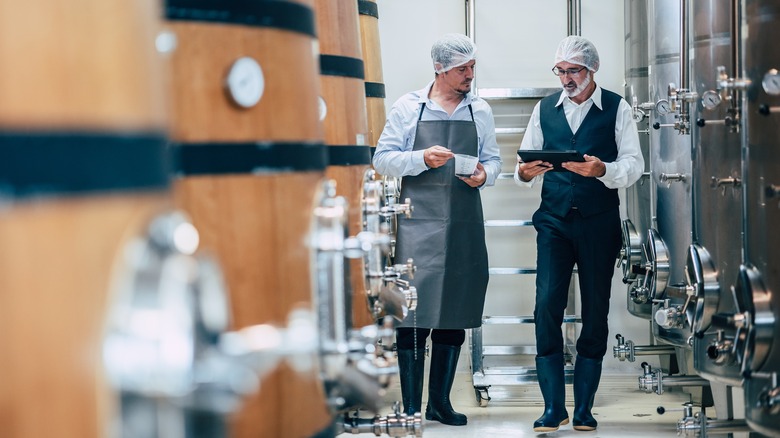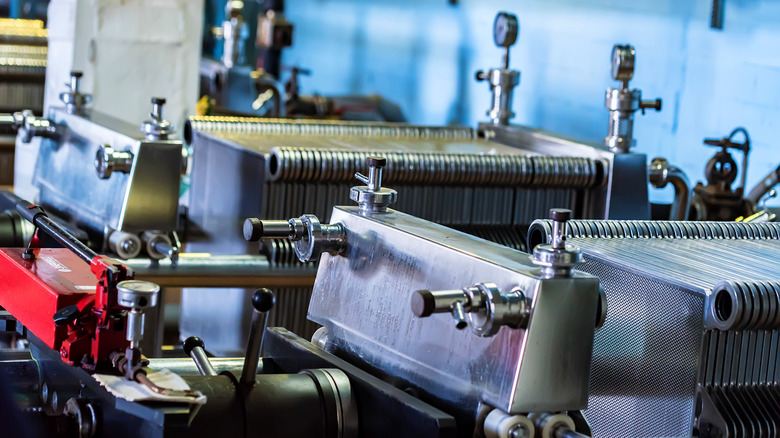How Non-Alcoholic Wine Is Actually Made
If you are someone who enjoys having a glass of wine with your dinner but wants to avoid or limit your alcohol intake, then you are probably familiar with the range of alcohol-free wines, but do you know how they're made? Often, people unfamiliar with modern dealcoholized wine brands assume it is just pasteurized grape juice, but that's not the case.
In fact, non-alcoholic or dealcoholized wine is fermented and made using the usual winemaking methods — the better varieties are even aged, just like traditional wine. Once a base wine is made, the alcohol is removed either through some form of distillation or reverse osmosis. Methods for crafting dealcoholized wine have improved, making it possible to remove most or all of the alcohol while retaining much of the antioxidants, tannins, and other flavor-enhancing compounds found in traditional wine. However, something is lost in the process. The alcohol in wine does more than intoxicate, it's part of the scent, texture, and taste.
Since each method also removes other desirable compounds, makers often reintroduce ingredients to refine the taste, scent, and mouthfeel. Skilled winemakers planning to craft dealcoholized often compensate by creating a base wine blend that will better hold its flavor after the alcohol is removed. Wine varieties requiring a single grape face additional challenges since they have fewer blending options, but they may add ingredients like grape juice to restore some of the lost elements. The methods used to remove alcohol are the product of innovation and offer the opportunity to enjoy the taste and benefits of wine without alcohol.
Using distillation to remove alcohol from wine
You may remember distillation from science class. It's a process where you turn a liquid into a gas, and then it is returned back into liquid, making it possible to remove some or certain components of the liquid. Distillation has been used for a long time to make spirits and may also be used to remove alcohol from wine. The problem is old-school distillation involves boiling wine, which changes its flavor. Fortunately, in the 19th century, German winemakers, the Jung family, developed vacuum distillation, hoping to sell their Riesling to teetotalers. The Jungs' method used added suction to lower the boiling point of the wine to 95 degrees Fahrenheit, which meant the wine would retain more flavor once the alcohol was removed.
The next major evolution in using distillation to remove alcohol from wine wasn't until the late 1980s when an Australian food chemist built upon vacuum distillation, developing a process that uses spinning cones to assist with extraction, per Smithsonian. The so-called Spinning Cone Column Method is the most efficient way to remove the alcohol in wine today and is much more versatile than previous methods. Flavourtech manufactures spinning cone vacuum distillation machines, and its equipment is used to extract flavor compounds from coffee to make instant coffee, flavor from fruits or spices to make extracts, and alcohol from wine and beer. It's even used to reduce alcohol levels in standard wines — either to offset excess alcohol created from highly sugary fruits or to reach a wider market of folks who want or need to reduce their alcohol intake but aren't looking to fully abstain.
Removing alcohol through reverse osmosis
Aside from distillation, the other major method for removing alcohol from wine is the Reverse Osmosis technique, which involves filtering wine through an ultra-fine filter to separate the water and alcohol from the other compounds in the wine. You end up with super concentrated wine without the liquids but containing the other compounds that make wine look, smell, and taste like wine.
Finally, the alcohol is distilled from the water and alcohol solution so the water can be used to dilute the concentrated wine. It can take up to four passes to completely remove the alcohol, per Wine Folly. The process isn't perfect since alcohol is part of the texture and scent of wine, and some of the other compounds that subtly enhance wine also get filtered out.
Whether the alcohol is removed through distillation or reverse osmosis, traces of alcohol may remain just like they do with kombucha and fruit juices. If these wines contain less than 0.5% alcohol but may still be labeled as non-alcoholic, per U.S. Food and Drug Administration regulations. When it comes to non-alcoholic wine, The FDA prefers either the term "dealcoholized" or "alcohol-removed" to appear before the word wine or the varietal name so consumers know it originated as traditional full-alcohol wine.
The craft of creating low and non-alcoholic wine continues to evolve. Winemakers are using growing and fermenting techniques to minimize alcohol, strategically blending the wine to balance the flavors, and continuing to improve on their methods for removing alcohol. As the craft improves, it may be easier than ever to enjoy the taste of wine without consuming alcohol.


